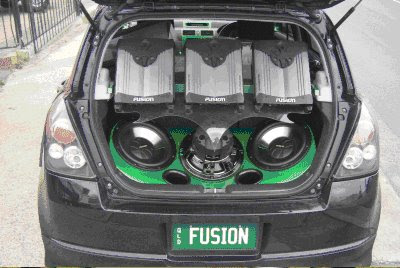
Despite recent technical advances, batteries are still pretty darn heavy and thus an obstacle to making EVs as weight-efficient as conventional cars. The 2012 Audi e-tron concept proves the point. For all the expensive pound-paring measures, it tips the scales at a fairly hefty 3,527 pounds, of which the batteries account for nearly a third. This helps explain why Audi put the batteries amidships. The resulting front/rear weight distribution works out to 42/58 percent, appropriate for a “mid-engine” sports car and on par with R8 ratios. The electric all-wheel drive is biased to suit, providing a normal power split of 30 percent front, 70 percent rear, and theoretically capable of sending all power to any one wheel, though Audi hasn’t yet spoken on that point.
Again like the concept, the production 2012 Audi e-tron should come with an “active-aerodynamics” package to further maximize efficiency and extend driving range. The term refers to a set of inner-body flaps and ducts arranged to smooth airflow over, under, around, and even through the car to reduce power-wasting air drag, especially at highway speeds. The concept does without a rear spoiler or other obvious “aero”-styling features, but designers have replaced conventional door mirrors with slim pods containing small rearview TV cameras that display on screens at the base of each windshield pillar inside. Audi hasn’t yet made aerodynamic claims, but we’d guess a low drag coefficient of 0.29 or better, judging from the smoothly contoured body lines.
The Competition
Mercedes-Benz SLK Class EV
Mercedes-Benz SLS AMG EV
Tesla Roadster
Also for efficiency’s sake, the 2012 Audi e-tron should inherit the concept’s low-power LED exterior lighting, something Audi has lately helped pioneer on production cars. The e-tron setup goes a step further in being able to vary headlight intensity, as signaled by a computer-linked camera, to match weather and traffic conditions; this also eliminates the need for separate fog lamps. Of course, the headlights are steering-linked. Still, Audi designers couldn’t resist a little visual brag, so the concept’s big “single-frame” grille is filled with LEDs that glow ice blue at night to make a positive, can’t-miss “environmental-impact statement.” We suspect this, too, will carry over to the production model.
The 2012 Audi e-tron should also inherit the concept’s ultra-clean, post-modern cockpit design with a dashboard, center console, and door panels that are styled and color-contrasted for a “floating” appearance. Drivers face a simple gauge cluster with a large, round speedometer and energy-use dials flanking a good-size screen for displaying navigation, climate, and infotainment info, as well as trip and traffic data. The screen is integrated with a new version of Audi’s MMI infotainment controller that retains a rotary knob and several buttons on the console, but is otherwise operated from the steering wheel by a smart phone-inspired touch pad. The gear selector is a wide paddle that rises into position on pushing the nearby “vehicle start” button, rather like the rotary shift knob on current Jaguars. This being an electric, the selector has but three positions: Drive (Forward), Neutral, and Reverse. A button directly below it operates an electronically actuated parking brake.
We’d expect the 2012 Audi e-tron will post excellent crash-test results, as engineers were doubtless mindful of the need to prevent impact forces from moving the high-voltage electrical components too close to occupants. A full set of airbags can be taken for granted. Other standard features are unclear at this early stage, but Audi’s new technical showcase will doubtless be very hard to get and very expensive, so it won’t lack for much, if anything. That should mean items like front- and rear-obstacle detection, rearview camera, and a mega-watt audio system (though that’s arguably less necessary in a near-silent EV). One final piece of equipment is a real gee-whizzer, but we’ll save that for “Notable Feature” below.
So what can you expect of the 2012 Audi e-tron once it hits the road? Plenty. Audi says the concept would do 0-62 mph (0-100 km/h) in 4.8 seconds “if necessary” and run a 37-75 mph sprint in just 4.1 seconds. Top speed is limited to a shade over 124 mph. Project Chief Krauter told Autocar that the e-tron will reach 160 mph, “but traveling at those speeds takes too much power out of the battery too quickly,” and that’s evidently a no-no for consumer EVs. Fuel economy? Audi isn’t quoting a miles-per-gallon equivalent, doubtless because the final product will have different calculations from the concept’s. The company does, however, claim a maximum driving range of 152 miles between charges, which is pretty good by current EV standards.
First reports from Frankfurt indicated that Audi was hesitating about a showroom e-tron because the concept apparently missed engineers’ targets for range, performance, and durability. The subsequent change of heart suggests either Audi believes it can meet those targets over the next three years--or that management just doesn’t want BMW, Mercedes, or any other premium brand to be first with an upmarket retail EV.
So yes, the parade down Electric Avenue has become a race for bragging rights and extra sales. It will be great fun to watch.
A Notable Feature of the 2012 Audi e-tron
Just as cell-phone technology now allows most any two people on earth to be connected, government planners, highway engineers, and traffic-safety experts are working toward the day when cars can communicate with each other as well as with satellites and ground stations. Audi calls this “car-to-x communication,” and touts a prototype for such a system as a special feature of the e-tron concept. No details are given, but the ultimate goal is a kind of rolling data network with all vehicles uploading and downloading information in real-time. Audi sees all this data being harnessed to reduce traffic congestion in crowded urban areas (via rerouting and “smart” traffic-light timing); to alert drivers on changing weather and traffic conditions, as well as the movements of vehicles nearby; even to help locate empty parking places. More crucially, such a network could help EV drivers locate the charging stations and battery swap-out facilities that are in the works as a necessary part of a supporting electric-vehicle infrastructure.
Engineers and various dreamers have talked about something like this for decades, and a few small-scale traffic-management systems have been operating in Europe and Japan for several years, though they rely on satellite signals and lack car-to-car capability. Still, “car-to-x” is rapidly becoming feasible, thanks to more-powerful computers and ever-lower hardware costs. Mind you, it’s still a good ways off, as Audi admits, but the company notes that “nearly every car maker in Europe, the U.S., and Japan have decided to develop a common standard for hardware and software. Once all new cars are equipped with this technology, a functional network of automotive transmitters will soon be available, at least in large population centers.” Nice though, but we may need another “cash for clunkers” program to pay for it.
2012 Audi e-tron Buying Advice
The 2012 Audi e-tron has no outside mirrors. Instead, screens on the base of each windshield pillar provide rear views. The e-tron Concept is shown here.
There’s little advice to give right now except to wait and see how good the finished product really is. As noted, the 2012 Audi e-tron concept looked virtually ready for production, so we suspect a little tweaking here and there is all Audi engineers have left to do. On the other hand, making batteries stronger (to extend driving range) is never easy, and we can see Audi accountants working overtime to ensure the e-tron will turn a profit, or at least not lose any money.
If nothing else, the 2012 Audi e-tron should spark up the high-end sports-car scene, especially if it arrives before battery-powered entries from BMW, Mercedes, and maybe others. Only one such car is currently on sale and that’s the $109,000 Tesla Roadster, which is assembled mostly by Lotus in England with an American-designed powertrain, and which has been hard to get for reasons that have little to do with Lotus or the car itself.
2012 Audi e-tron Release Date: There’s nothing official yet, only word from Audi of America Chief Johan de Nysschen that the e-tron will be on sale within three years. Various outside sources suggest the car will bow as a 2012 model, though it could be an ’11 or ’13, depending on how things go.
2012 Audi e-tron First Test Drive: Assuming Audi can stick to the intended schedule, we’d look for a series of ride-and-drive previews, perhaps starting in late 2010, to build up interest and keep e-tron in the news until the first customer cars are delivered.
2012 Audi e-tron Prices: With the new V10-engine R8 5.2 starting at $146,000, the 2012 Audi e-tron will certainly price a good deal higher. It does, after all, employ similar aluminum-space frame construction, plus carbon-fiber body panels and a half-ton of Li-ion batteries, none of which come cheap. So how much might it cost? We can only guess at this point, but $200,000 isn’t out of the question, especially as this car would probably be built largely by hand and marketed as a green-technology flagship available to a monied few with an environmental conscience. But the rest of us needn’t despair. As we see it, the e-tron is really a testbed for EV-production methods and real-world owner experience that will pave the way for more-affordable all-electric Audis later in the coming decade.
2012 Audi e-tron Preliminary Specifications
The 2012 Audi e-tron may cost about $200,000. The e-tron Concept is shown here.
The Basics
Vehicle Type: premium sporty/performance car
Drivetrain (concept; manufacturer data)
Drive wheels: all
Engine: 4 asynchronous electric motors (2 front, 2 rear) with 42.4 kw/h lithium-ion battery pack
Horsepower: 313
Torque: 3,319 lb-ft
Transmission: 2 single-speed reduction gearboxes
Dimensions (concept; manufacturer data)
Wheelbase: 102.4 inches
Length: 167.8 inches
Width: 74.8 inches
Height: 48.4 inches
Base curb weight: 3,527 pounds
For more inside information on hundreds of new cars of today and tomorrow, check out:
2010 Audi R8 Review and Prices
2009 Consumer Guide Best Buy and Recommended Award Winners: Check out which cars won our Best Buy and Recommended awards for 2009.
Future Cars: Step into the automotive showroom of tomorrow with reviews, analysis, pictures, prices, and preliminary specifications on scores of vehicles that will be appearing next year and beyond.



























